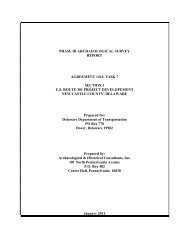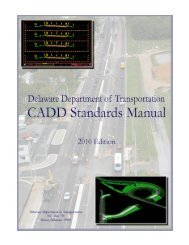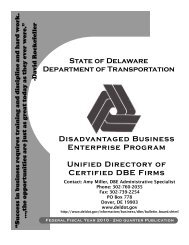Gulph Creek Stone Arch Bridge - Delaware Department of ...
Gulph Creek Stone Arch Bridge - Delaware Department of ...
Gulph Creek Stone Arch Bridge - Delaware Department of ...
Create successful ePaper yourself
Turn your PDF publications into a flip-book with our unique Google optimized e-Paper software.
Chapter 3—Historic Context for Common Historic <strong>Bridge</strong> Types<br />
bridges up to the mid-1950s, when prestressed concrete and steel bridges began to be<br />
used (26). In New Jersey, timber stringer bridges were reportedly built as late as the<br />
1990s, particularly in the southern portion <strong>of</strong> the state (27). In Maryland, timber beam<br />
bridges were once found in abundance in the Tidewater region. In Colorado, they have<br />
historically been the most common bridge type and there are seven timber stringer<br />
bridges in the state that are NRHP listed or eligible. In West Virginia, there are currently<br />
24 timber stringer bridges on the <strong>Department</strong> <strong>of</strong> Transportation state inventory (not all <strong>of</strong><br />
historic age). In Georgia, the State Highway <strong>Department</strong> adopted a standard design for<br />
timber beam bridges in 1919, and more than 100 pre-1956 examples were identified<br />
during research for the Historic <strong>Bridge</strong> Inventory Update (28).<br />
Timber stringer (beam) bridges consist <strong>of</strong> a wood plank deck supported by heavy,<br />
square or rectangular, solid-sawn wood beams. Short span timber stringer bridges in the<br />
10- to 30-foot range were and are built in areas that do not carry a high level <strong>of</strong> traffic<br />
and in parks. They are built as approach spans to metal truss, beam or girder bridges or<br />
as trestles. The timber beam (stringer) bridge differs from the wood trestle bridge, which<br />
is addressed in Section 3.6 <strong>of</strong> this chapter, primarily by the type <strong>of</strong> substructure<br />
employed. According to Historic <strong>Bridge</strong>s in North Dakota (29), whereas the ends <strong>of</strong> the<br />
stringers in a timber stringer bridge rest on a single vertical support constructed <strong>of</strong> stone,<br />
concrete, wood, or steel piles, the stringers <strong>of</strong> a timber trestle bridge rests on a framework<br />
<strong>of</strong> vertical members joined together with horizontal and diagonal bracing.<br />
Significance Assessment: Timber stringer bridges have a relatively low level <strong>of</strong><br />
significance within the context <strong>of</strong> this study. Very old (pre-twentieth century) examples<br />
would possess significance as an early representative example <strong>of</strong> the type if they retain<br />
integrity. Character-defining features include the longitudinal beams (or, stringers) and<br />
<strong>of</strong>ten the pile bents. Railings and abutments may or may not be considered characterdefining<br />
features. Intact examples in parks are also significant as they generally have<br />
scenic values and <strong>of</strong>ten possess additional significance for their association with parks<br />
and/or Depression-era federal work programs. If a stringer bridge could be identified as<br />
having been built according to the standard plans <strong>of</strong> the state transportation departments,<br />
it would also be considered significant within the context <strong>of</strong> this study. One problem with<br />
timber stringers and integrity, <strong>of</strong>ten maintenance results in the loss <strong>of</strong> the structure’s<br />
materials to a point where little will remain <strong>of</strong> the historic fabric.<br />
Examples <strong>of</strong> Timber Stringer<br />
1. Maitland Arroyo <strong>Bridge</strong> (1940), Huerfano County, CO. NRHP listed<br />
2002 in Highway <strong>Bridge</strong>s in Colorado MPS.<br />
2. Grist Mill <strong>Bridge</strong> (ca. early 1950s), York County, ME. NRHP listed 1990.<br />
3. Fishing <strong>Bridge</strong> (1937), spanning Yellowstone River at East Entrance<br />
Road, Yellowstone National Park, Park County, WY. HAER WY-9.<br />
4. Lithodendron Wash <strong>Bridge</strong> (1932), AZ. NRHP listed 1988 in Vehicular<br />
<strong>Bridge</strong>s <strong>of</strong> Arizona MPS.<br />
5. Warrens <strong>Bridge</strong> (1930) over Lambrook Levee Ditch on CR 14, Phillips<br />
County, AR. NRHP listed 1995.<br />
3-81






